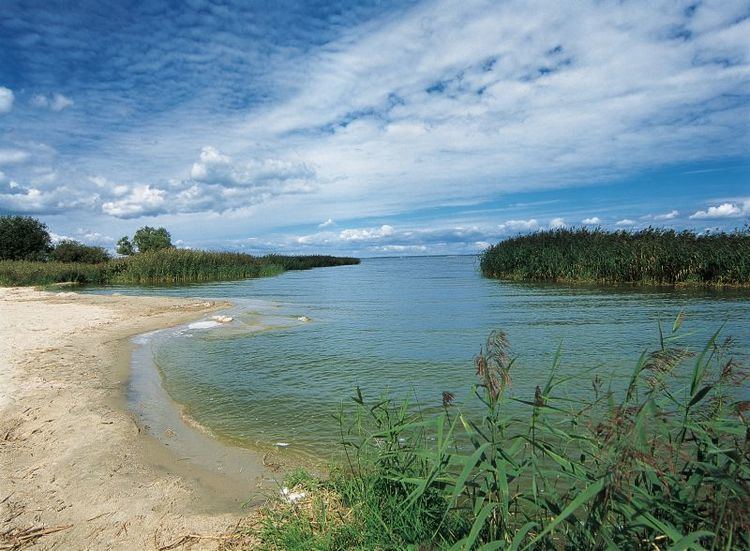 | ||
Similar | ||
Szczecin Lagoon, Stettin Lagoon, Bay of Szczecin, or Stettin Bay (Polish: Zalew Szczeciński, German: Stettiner Haff), also Oder lagoon (German: Oderhaff), is a lagoon in the Oder estuary, shared by Germany and Poland. It is separated from the Pomeranian Bay of the Baltic Sea by the islands of Usedom and Wolin. The lagoon is subdivided into the Kleines Haff ("small lagoon") in the West and the Wielki Zalew (German: Großes Haff, "great lagoon") in the East. An ambiguous historical German name was Frisches Haff, which later exclusively referred to the Vistula Lagoon.
Contents
Map of Szczecin Lagoon
Geography
From the South, the lagoon is fed by several arms of the Oder river and smaller rivers like Ziese, Peene, Zarow, Uecker, and Ina. In the North, the lagoon is connected to the Baltic Sea's Bay of Pomerania with the three straits Peenestrom, Świna and Dziwna, which divide the mainland and the islands of Usedom and Wolin .
The lagoon covers an area of 687 km², its natural depth is an average 3.8 metres, and 8.5 metres at maximum. The depth of shipping channels however can exceed 10.5 metres. Thus, the lagoon holds about 2.58 km3 of water. The annual average water temperature is 11 °C.
94% of the water loads discharged into the lagoon are from the Oder river and its confluences, amounting to an average annual 17 km3 or 540 m3 per second. All other confluences contribute a combined annual 1 km3. Since no reliable data for an inflow from the Baltic Sea exist, the combined inflow is an estimated 18 km3 from a catchment area of 129,000 km2, residing in the lagoon for an average 55 days before being discharged into the Pomeranian Bay. The nutrients thereby transported into the lagoon have made it hyper(eu)trophic to eutrophic. The straits Peenestrom, Świna and Dziwna are responsible for 17%, 69%, and 14% of the discharge, respectively.
The average salinity is between 0.5 and 2 psu, yet at times more salt water penetrates through the Świna locally raising the salinity to 6 psu.
Towns around the Lagoon
History
In 1880, the Kaiserfahrt ("Emperor's passage") channel on Usedom was opened, a water route with a depth of 10 metres connecting the lagoon with the Baltic Sea by bypassing the eastern part of the Swine, allowing large ships to enter the lagoon and the seaport of Stettin quicker and safer.
The canal, approximately 12 km long and 10 metres deep, was dug by the German Empire between 1874 and 1880, during the reign of the first Kaiser Wilhelm (1797–1888) after whom it was named. Also, the work resulted in a new island named Kaseburg (Karsibór) being cut off from Usedom.
After 1945, the areas east of Oder Neisse line became part of Poland, including the former German seaport cities of Stettin (Szczecin) and Swinemünde (Świnoujście) on the western bank of the river Oder. The Kaiserfahrt was renamed Piast Canal, after the Polish Piast dynasty.
The German-Polish border also divides the bight called Neuwarper See near Rieth, Luckow.
Economy
The lagoon has served as an important fishing grounds for centuries, as a major transportation pathway since the 18th century, and as a tourist destination since the 20th century.
Recreation
Today the lagoon offers a selection of passenger ship tours, a wide range of water sports and some notable beaches. Tourists can discover winegrowing, the narrow-gauge railway, museums, castles, many hiking and cycling routes and a small village reviving the life of the former Slavic settlements.
Pollution
The lagoon suffers from heavy pollution, mainly from the Oder river, resulting in eutrophication. High concentrations of aluminium and iron sediments have been found in the river causing rapid algae growth inside the lagoon. However, long-term nutrient concentrations show a high inter-annual variability and have declined during recent years.
